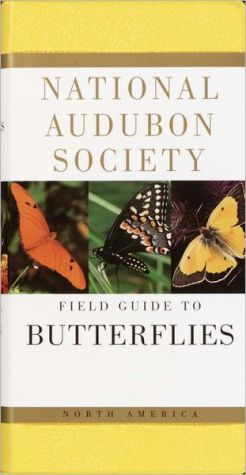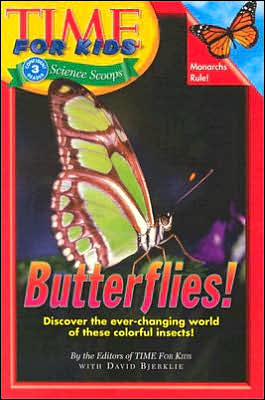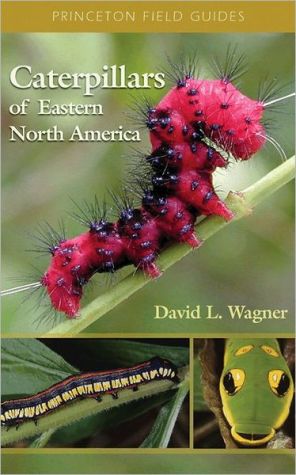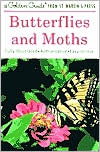Kaufman Field Guide to Butterflies of North America
The most user-friendly butterfly guide ever published, still handy and compact, now updated with the very latest information\ - Follows the latest classification, recognizing more than forty additional species\ - Includes four new color plates of Mexican-border rarities\ - More than 2,300 images of butterflies in natural poses\ - Pictorial table of contents\ - Convenient one-page index\ - Range maps on text pages
Search in google:
The most user-friendly butterfly guide ever published, still handy and compact, now updated with the very latest information- Follows the latest classification, recognizing more than forty additional species- Includes four new color plates of Mexican-border rarities- More than 2,300 images of butterflies in natural poses- Pictorial table of contents- Convenient one-page index- Range maps on text pages
ENJOYING BUTTERFLIES A Note from Kenn Kaufman\ Most people seem to be aware of butterflies more as symbols than as real living creatures. Although there are hundreds of species of butterflies in North America, they somehow escape public notice most of the time. Out in plain sight, they lead secret lives.\ I still recall how surprised I was when I began to notice them myself. At the age of fourteen, having learned a lot of my local birds, I decided to see if there were any butterflies in the neighborhood. Amazingly, as soon as I began looking for them, they appeared: Little Wood-Satyrs flopping through the woods, tiny Reakirt’s Blues on weed flowers in vacant lots, and dozens more. Although I had been outside looking for birds, up to that time I had utterly missed these other winged creatures. Butterflies are not birds, of course. They are very different in their habits, yearly cycles, and population dynamics. And they’re a lot smaller. The biggest ones, like Monarchs and Giant Swallowtails, may grab our attention, but most of the diversity is among the smaller butterflies. We have far more species of little hairstreaks, blues, skippers, and the like than we do of the big guys. Small can be beautiful: even the tiniest butterflies have intricate patterns that are well worth appreciating. But until recently, it has been extremely difficult to identify many of these butterflies in the field. Even separating some larger species has been problematic, because their identification often depends on small details. Until the recent development of good close-focusing binoculars and cameras, many butterflies could be recognized only by expert lepidopterists with vast experience. I have been lucky enough to have one such lepidopterist as a good friend for years, and luckier still that he is the kind of expert who is always ready to share his knowledge. Jim Brock has studied butterflies from Alaska to Brazil, and in the field he dazzles everyone with his ability to find and identify even the rare and little-known species; but he will also patiently point out the most common butterflies to anyone who wants to know them. Jim agreed to coauthor this book as a way of helping new- comers to the field. In doing so, he graciously accepted the challenge of our Focus Guide format: boiling his vast knowledge down to just the essentials that would be most useful in a pocket-sized book. If any serious lepidopterists are displeased by the treatments here, they should blame me, not Jim Brock. But of course serious lepidopterists (who already have their technical reference works) are not the primary audience for this book. The Focus Guides are shortcuts, intended to be the best and fastest way to get started in a subject, to send you outside quickly, putting names on what you find. Slip this book into your pocket the next time you go exploring, and start discovering the secret world of butterflies for yourself.\ IDENTIFYING BUTTERFLIES In naming a butterfly, the first step is to make sure that it really is one. The order Lepidoptera includes the moths as well as the butterflies, and some moths are active by day and are quite colorful. Usually they sit or behave in an obviously different way from butterflies. If in doubt, look at the antennae. On butterflies, the tip of each antenna has a thickened area, or “club.” North American moths lack this feature; their antennae are either threadlike to the tip, feathery, or fringed along the edges.\ Butterflies have four wings: two on each side, the forewing and the hindwing. The upperside and underside of each wing usually has a different pattern. To describe a color pattern on a butterfly, therefore, we have to say where it is—for example, on the upperside of the forewing. Lepidopterists can describe butterfly patterns in great detail using a system of numbering the wing veins and the spaces between them. It’s hard to apply that system to an active butterfly in the wild, so we don’t use it in this guide, except to point out the cell, an area outlined by veins near the base of each wing. However, a few terms are necessary for communicating about the intricate patterns of some species; see the diagrams below for the simplified terminology used in this guide.\ What to look for: Wing patterns are obviously important in identifying butterflies, but they are not the only clues. Here are some other points to consider.\ Size: Some swallowtails are six inches or more from one wingtip to the other, while some blues are much less than an inch across. Since these wingspan measurements are hard for most people to visualize, we have treated sizes in this guide by showing one individual on each color plate at actual lifee size in gray outline. The illustrations are in correct scale relative to the others on that page, but not necessarily to those on other pages; be sure to check the “actual size” figure each time you turn the page, to get an idea whether the butterflies shown are actually big, medium-sized, or small. Little butterflies do not grow up to be big ones: once they complete the transformation to winged adult, their size does not change. However, there are variations within a species. Early spring individuals are often smaller than those of summer; females are often larger than males. And occasionally we see a “runt” individual that is oddly small. But with experience, you will find that size is usually a good quick clue to identification.\ Shape: At a glance, most butterflies may seem to be roughly the same shape. With closer study, you will begin to see differences in wing shapes that help to create the distinctive look of each species. Some have extended “tails” on the hindwings, or jagged or scalloped outer wing margins. Other differences are much more subtle, such as the wingtips being slightly more rounded or pointed. But with practice you will find that a butterfly’s shape is an important identifying mark.\ Posture: The way a butterfly sits is always worth noticing. Sulphurs almost always perch with their wings folded tightly above their backs; metalmarks usually have their wings spread out flat; cloudywings usually hold their wings half open in a shallow V; and grass skippers often hold their hindwings spread farther than their forewings. Any butterfly may sit in an odd position at times, but the typical posture can be a good clue to identification. We have tried to illustrate and describe this for all species.\ Flight style: Experts often can recognize a butterfly as it flits past—not because they can actually see detailed field marks on its fast-moving wings, but because the way it flies is a field mark in itself. Some species fly erratically, others more directly; some flutter along with regular steady flaps, while others flap a few times quickly and then glide. These flight styles are hard to describe in words, but with practice you will learn to recognize many of them.\ Fine details: Some field marks involve very small details, such as the colors of the eyes, the color or pattern on the antennae, or the color of the “face” (the palps, on the front of the head). These things really can be seen in the field, but for wary species you may need to use binoculars. Good binoculars are now available that can focus as close as just a few feet away, allowing incredible views of butterflies and other small creatures. One good source of information on binoculars for butterfly-watching can be found online at www.eagleoptics.com.\ Variation in butterflies: As with humans and other living things, no two individual butterflies look exactly alike. Most of the variation within a species is so minor that you won’t notice it in the field, but sometimes it’s enough to cause confusion. Occasionally you’ll see an individual that looks totally unlike the normal color pattern for its species; these aberrant butterflies may be identifiable only by shape or other clues. Many species vary from place to place, and if these variations are well marked, a local or regional population may be designated as a subspecies; see p. 14 for more information. There are also seasonal variations. For example, Zebra Swallowtails flying in spring are smaller and paler than those flying in summer, even though they all belong to the same species; Goatweed Leafwings flying in fall have more sharply pointed forewings than those flying in early summer. Males and females often differ in pattern or even in shape—sometimes subtly, sometimes so strikingly that they appear to be unrelated. And finally, every individual butterfly gradually changes in appearance as its condition becomes more worn and faded. The two Painted Ladies shown here, for example, were sitting on flowers in the same meadow. The ragged one on the right can still be identified, because Painted Ladies have lots of field marks, but some butterflies in this condition would be unrecognizeable.\ Habitat and season: Many butterflies are restricted to particular habitats, and this is a key not only to finding them but to identifying them. We give habitat descriptions for most species in this guide, and these should always be considered. Seasons are important as well. Even in warm climates, only a few species are on the wing year-round; in most species, adults are present only in certain seasons. We usually describe these flight seasons in general terms, such as “early summer,” and these designations relate to local conditions, not arbitrary calendar dates. The Sara Orangetip, for example, is an early spring butterfly. It may appear by late January in Arizona and not until the end of May in the Yukon Territory, but those dates qualify as “early spring” in both locations.\ About the illustrations: Naturalists have debated for years whether field guides should be illustrated with paintings or photographs. This book uses a third method, introduced in 2000 with the first Kaufman Focus Guide, Birds of North America: we begin with photos and edit them digitally to make them all directly comparable, as paintings would be. Some butterflies, such as sulphurs, never bask with their wings open; but it is still useful to know the colors of their uppersides, because even at a glimpse in flight, a pale yellow one will look different from an orange one with black borders. For most species like this, we provide illustrations at reduced size showing their uppersides as an aid to identification. Understanding the range maps: One of the most important clues to identification involves knowing where you are. Most butterflies have very specific ranges and are unlikely to be seen anywhere else. This is a good thing, because some groups include similar species that are much easier to tell apart by range than by field marks. For example, Eastern and Western Tailed-Blues look very much alike, but in most places you will find only one or the other, not both. In identifying any butterfly, always check the range maps to see which ones are likely in your region. Most of the range maps in this guide have the distributions of the butterflies indicated in green. This color means that the species is flying in summer (the peak butterfly season in most areas) or in more than one season (for example, spring and summer, or even most of the year). We use a darker shade of green for areas where the species is most common, and a paler shade for areas where it is less likely to be seen. These designations are quite arbitrary, but we hope they will be helpful in giving a general idea of which species are most expected. A few species fly mainly in spring or mainly in fall; these are mapped in blue for spring, orange for fall, again with a darker shade for the areas where they are more common.\ Some butterflies, especially from southern regions, sometimes stray far from their normal haunts. If there is a regular pattern of such straying, we indicate it on the map with a dashed line beyond the typical range.\ FINDING BUTTERFLIES Some butterflies are adaptable and may show up almost anywhere, but most prefer a particular habitat. You will not see Salt Marsh Skippers in a forest or Desert Elfins in a marsh. To see a wide variety of butterflies, therefore, it’s necessary to visit many habitats. You should go at various seasons, because many species have rather short flight periods: Falcate Orangetips fly only in spring, Apache Skippers only in fall. This adds to the enjoyment of butterfly watching, because you can hope to see different species on repeat visits to the same place during the year.\ Flowers: Not all butterflies fit the classic image of visiting flowers to sip nectar—some species are rarely or never seen at flowers. Still, to get started, the easiest way to find butterflies is to find a good patch of blooms in a garden or meadow, or by a roadside. Some flowers seem to be more attractive than others, and some butterflies prefer certain types of flowers, so it pays to look in a variety of places.\ Mud: Males of some butterflies, including blues, swallowtails, and sulphurs, are strongly attracted to damp soil. They are apparently taking in salts and other chemicals from the mud. Sometimes these “puddle parties” involve several species and hundreds of individuals, while at other times only a few individuals will be present, but you should always check puddles and pond edges for the presence of butterflies.\ Other baits: Many butterflies are attracted to odd things such as flowing sap, rotting fruit, or animal dung. (This is especially true of some species that tend to ignore flowers, such as the Goatweed Leafwing and the Question Mark.)\ Aside from these feeding behaviors, adult butterflies put most of their energy into activities related to reproduction. Males spend a lot of time looking for females; females spend much time looking for the right places to lay their eggs. Knowing their behaviors can help you find them.\ Hilltopping: Male butterflies of some species look for mates by flying to the top of a hill and patrolling or waiting there for the females to show up. If we check the tops of low hills, especially from late morning to afternoon, we may see butterflies that are hard to find in the surrounding country.\ Patrolling: Males of other species fly back and forth along linear pathways, such as trails or gullies, looking for females. They may come back time after time to the same perches, allowing for repeated views.\ Foodplants: Many butterflies are closely tied to the plants on which their larvae feed. Hessel’s Hairstreaks are seldom seen away from Atlantic white cedars; Square-spotted Blues are usually seen sitting on buckwheats. A skilled lepidopterist is often able to find particular butterflies by learning to recognize their larval foodplants.\ THE BUTTERFLY’S LIFE CYCLE The amazing process of metamorphosis—the butterfly’s transition from egg to caterpillar to pupa to winged adult—is well known and fairly well understood, but it is still rightly regarded as a miracle.\ The process begins with the egg laid by the adult female on or near the plants that will serve as food for the caterpillars. Most butterfly caterpillars cannot survive on the wrong plants, so the adult’s choice of where to lay her eggs is critically important. But given the right plant, the caterpillar or larva (plural: larvae) is a little eating machine, and as it grows it passes through about five stages, or instars, each one larger than the last. Because the larva’s skin can stretch only so far, it sheds its skin each time it passes to the next instar. The last time it sheds its skin, it reveals not a larger larva but the next phase in its life, the pupa (plural: pupae). The pupa, also called the chrysalis, is the stage in which the larva is transformed into the adult butterfly. Unlike many moths, most butterflies do not spin a protective cocoon; their pupa is smooth but often colored for camouflage. When the development inside is complete, the pupa splits open and the adult crawls out; after an hour or two for the wings to expand and dry, the butterfly is ready for flight. In cooler climates, butterflies have the challenge of surviving through winter. Some pass the winter as eggs, others as partly grown larvae or as pupae. A few overwinter as adults, emerging to fly about on unusually warm winter days. But aside from such hibernators, and a few large species such as Monarchs and longwings, most butterflies do not live very long in the adult stage—a couple of weeks is a long life for a small butterfly.\ In some cases, a butterfly passes through all four stages in a matter of weeks, and the whole cycle is repeated several times during the year. In this guide we note how many generations, or broods, a species may have per year. Many species have only one brood per year, and these usually have short flight seasons. Some have fewer than one brood per year: in the far north, where summers are short, some species take two years to develop, hibernating through one winter as a small larva and the next winter as a nearly full-grown larva; adults may appear only every other year. Some butterflies found in northern climates cannot survive the winter there in any stage. Instead, they invade northward every summer, with some of their offspring surviving to move south in fall. These migrations generally seem far more haphazard than those of birds, but so far they are not well known.\ HOW BUTTERFLIES ARE CLASSIFIED AND NAMED The sheer variety of nature is wonderful, but it can also be very confusing. To make sense of this diversity, scientists classify living things in categories such as order, family, subfamily, genus, and species. All butterflies (and all moths) are classified in the order Lepidoptera. The color-coded sections in this guide are built around families or subfamilies of butterflies. For most of us, the most interesting category is the species—the basic “kind” of butterfly that we write on our list of sightings.\ Species of butterflies: Whole books have been written to define exactly what a species is. No definition will fit perfectly, because there are many borderline cases, populations that appear to be in the process of becoming species but are not yet quite distinct enough. In general, members of a species are isolated from members of other species in terms of reproduction. Different species often can interbreed (and may even produce fertile offspring), but they generally don’t. For example, Crossline and Tawny-edged Skippers (p. 324) look very similar to us, but they occur together over a wide area without interbreeding, so they are clearly separate species. On the other hand, the Red-spotted Purple and the White Admiral (p. 210) look quite different, but they seem to interbreed randomly where their ranges meet, forming a broad blend zone in the northeast; they are regarded as forming just one species. Lorquin’s and Weidemeyer’s Admirals (p. 212) also may interbreed in the narrow zone where they meet, but much less frequently; they are still considered to be separate species.\ Subspecies: Members of a species do not all look the same. Aside from the kinds of individual variation mentioned on p. 9, they may vary consistently from one place to another. These regional variations, if they are well marked, may be formally described by scientists as subspecies. Subspecies within a species will interbreed wherever their ranges come in contact, so the divisions between them are not precise. In some cases a species will vary gradually over a wide area (becoming gradually paler from east to west, for example), and dividing this kind of clinal variation into subspecies is arbitrary and not very useful. But if a subspecies has an isolated range and is not in contact with other populations of its species, it may be very distinctive, and may eventually become a full species.\ In most cases we ignore subspecies in this guide, since the differences are usually not obvious in the field. But if you develop a serious interest in butterflies, you will discover a whole additional level of diversity by delving into their subspecific variation.\ Scientific names are applied to every known species. Mainly Latin or Latinized Greek, these names are recognized by scientists working in any language. The names are written in italics: Limenitis archippus is the Viceroy. The first word is the genus: Limenitis. The Lorquin’s Admiral, Limenitis lorquini, belongs to this same genus, so it is a close relative of the Viceroy in spite of its different colors. If the scientific name consists of three words, the third one is the subspecies. Limenitis archippus floridensis is the dark subspecies of Viceroy living in Florida.\ Standardized names: For some other groups of organisms, such as birds and dragonflies, there are official publications (produced by committees of expert scientists) that list all valid species and give standardized scientific and English names for each. For butterflies, however, this has not been done, and many different classifications and names have been used—you might find the same butterfly called by three different names in three books. To address this confusing situation, a committee of enthusiasts from the North American Butterfly Association (NABA) has compiled The NABA Checklist & English Names of North American Butterflies (second edition, 2001). Although this is not really an “official” list and is not followed by all lepidopterists, it has proven to be tremendously useful for amateur butterfly watchers. In this book, for the sake of convenience, we have followed the NABA list in almost all cases.\ Most people who use English names for butterflies today use names that identify them only to species, not to subspecies, except in a few cases involving populations that are very notable for some reason (such as the San Bruno Elfin, an endangered subspecies of Moss’s Elfin).Unless you plan to become deeply involved in taxonomic issues, it is usually easier to stick with species names. However, some lepidopterists with a strong interest in subspecies have suggested that each one should have its own English name. We don’t follow this practice, but we should point out that a list of suggested English names for all North American subspecies of butterflies can be found online at http://tils-ttr.org/lepnames.html.\ The unknown: In this guide we have presented all North American butterflies in a way that reflects our current understanding of how they should be classified. However, no one should assume that this is the final word. Scientific understanding of some groups is still developing. For example, the little Spring Azure was long regarded as one variable species found all over North America. There is now good evidence that it is actually a complex of species, perhaps seven or more. Similar complexes may exist within what we now call the Square-spotted Blue, Dotted Blue, Juniper Hairstreak, Common Ringlet, Mormon Metalmark, Mustard White, and others. We still have much to learn about them. As an example of how much remains unknown, as this book was going to press, we received word of a new species described to science. It was not a drab, small butterfly from a remote wilderness, but a large, spectacular one in the eastern United States! This creature, the Appalachian Tiger Swallowtail (P. appalachiensis), had been overlooked because of its similarity to the Eastern Tiger Swallowtail; but it flies only in spring, has no black form of the female, is larger than the spring brood of Eastern Tiger, and has a narrower black and blue outer edge on the hindwing. Opinions are still divided as to whether this is really a valid species, but it looks promising, it hints at exciting discoveries remaining to be made.\ OTHER ACTIVITIES INVOLVING BUTTERFLIES\ Butterfly gardening: This is becoming tremendously popular in many parts of North America, as people discover that they can add the beauty of butterflies to their gardens. Whole books have been written on how to do it. The details vary from one region to another, but the basics are the same everywhere: plant some flowers for nectar to attract the adults, and plant some foodplants for the larvae (caterpillars). The latter aspect is sometimes neglected, but it is very important. By planting to feed the larvae, you can actually increase local populations of butterflies, not just attract a few adults that happen to be passing through. And whatever you do, don’t spray pesticides in your garden. Butterflies are insects; pesticides kill insects (along with lots of other things). A living garden with butterflies and bugs and other creatures may have holes chewed in the leaves, but it will still be far more beautiful than a “perfect” garden that has been sprayed and poisoned into sterility.\ Butterfly photography: While bird photography usually requires bulky, expensive telephoto lenses, butterflies can be approached closely and photographed without much special equipment. A good macro lens is needed for the smaller species, and flash is helpful. Our colleagues Rick and Nora Bowers, who contributed more images to this book than any other photographers, almost always use artificial light—a ring flash or a bracket with two flash units—to get the best detail, color, and depth of field. But in some situations it is possible to get very pleasing shots with natural light.\ Digital cameras have added a new dimension to butterfly photography. They are improving rapidly, and the latest models do an amazingly good job of capturing sharp closeups. We (Bowers, Brock, and Kaufman) are all still using film and then making digital scans from the slides, but we suspect that our conversion to straight digital photography is not far off. The field is wide open for aspiring butterfly photographers. While Monarchs and a few others have been photographed many times, there are very few images available for many of the skippers, hairstreaks, and others (as Nora Bowers discovered in trying to track down all the images for this guide). If you seek out some of the less common butterflies, you may wind up taking the world’s best photos of those species.\ Visiting butterfly houses: In recent years, live butterfly exhibits have opened in many parts of North America. While we generally prefer to search for butterflies in the wild, these exhibits can be fascinating places to visit. They usually feature large, showy species from tropical regions. Often the “livestock” is supplied by firms in the developing countries of the tropics, and these companies provide local people with a good income and an incentive to preserve some pieces of natural habitat for butterfly populations. Therefore, in addition to their educational value for visitors, these butterfly houses are often supporting good social and conservation causes as well.\ Conservation: The most important thing you can do with butterflies is to help preserve their wonderful diversity. One of our main objectives in writing this guide was to inspire more people to notice and appreciate butterflies so that there would be more support for their conservation. The main threat facing butterfly populations is loss of habitat. Some of our most beautiful butterflies, such as the Regal Fritillary and the Hermes Copper, have disappeared from much of their former range because their specific habitats have been destroyed. Preserves for butterflies do not have to be very large, but without them we will certainly lose some species.\ Pollution of their surroundings, especially with insecticides, poses another problem. Widespread, indiscriminate spraying for gypsy moths has undoubtedly killed billions of butterflies, along with countless numbers of our beautiful silk moths and others. Several butterflies in southern Florida have become quite rare in recent years, and we have to wonder whether heavy, continuous spraying for mosquitoes may have been a factor.\ Uninformed persons sometimes imagine that butterfly collectors pose a threat also, but there is scant evidence for this. During an average week in summer there are probably more butterflies killed by cars on American roads than the total taken by all the collectors in history. For any would-be protectors of butterflies, harassment of net-wielding lepidopterists is a waste of time; habitat protection is a more worthwhile effort.\ Two conservation groups especially deserve support. The Xerces Society, 4828 Southeast Hawthorne Blvd., Portland, Oregon 97215. Named for the Xerces Blue, a butterfly that was driven to extinction by habitat loss in the 1940s, this organization works for the conservation of butterflies and other invertebrates. The Nature Conservancy, 1815 Lynn Street, Arlington, Virginia 22209. This pragmatic organization protects habitat in a very direct way, by buying it. The Nature Conservancy has many good biologists on staff, including some expert lepidopterists, and in working to save particular habitats they take into account the needs of rare butterfly species.\ Relations between watchers and collectors: We assume that most users of this guide want to watch butterflies, not collect them. Collecting requires a lot of equipment and a lot of work, and most people find it easier just to enjoy live butterflies in the wild. However, these new watchers or “butterfliers” should recall that essentially all of our knowledge of butterfly classification and distribution is based on the work of collectors. They are the pioneers and discoverers, and their work is not finished.\ Not all butterflies can be identified in the field, and collected specimens are essential for study. Species of butterflies new to science are still being discovered, and they must be scientifically documented before their habitat can be protected, so collecting is an essential part of both science and conservation. We have no evidence that collectors have ever caused the extinction of a butterfly species—but a strident anticollecting attitude might result in some species going extinct without having been discovered.\ Copyright © 2003 by Hillstar Editions L.C. Reprinted by permission of Houghton Mifflin Company.
PICTORIAL TABLE OF CONTENTS\ WHEN YOU SEE AN UNFAMILIAR BUTTERFLY: 1. Try to place it in one of the groups shown on the next four pages. Its shape, size, and behavior may be better clues than color. 2. Refer to the page numbers or color tabs and go to that section of the book. Look for the pictures that match your butterfly most closely.\ 3. Make sure the size is right. Always check the “actual size” figure in the upper right-hand corner of each plate.\ 4. Check the range maps to see which species are likely in your area. This will help to narrow down the choices.\ 5. Read the text for additional pointers on habitat, behavior, flight season, and comparisons to similar species.\ SWALLOWTAILS AND PARNASSIANS, pages 2045 Swallowtails are mostly large, with sailing or fluttering flight. Many have “tails” on hindwings. They rest with wings open or closed. Parnassians are only in parts of west and far northwest.\ WHITES AND SULPHURS, pages 4677 Very small to very large, but mostly medium-sized. Rapid fluttering flight. Most kinds are white, yellow, or orange. Whites may sit with wings open, but sulphurs sit with wings folded above their back.\ COPPERS AND HARVESTER, pages 8091 Coppers are fairly small, visiting flowers, often sitting with wings open. Harvester is scarce, found around alders in the east.\ HAIRSTREAKS, pages 92123 Small butterflies with fast, erratic flight. Most sit with their wings folded above their back; only a few bask with wings spread.\ BLUES, pages 124141 Small to very small, with fluttering, erratic flight. They may sit with wings folded or partly open. Often seen on flowers or at puddles.\ METALMARKS, pages 142151 Mostly tropical; ours are mostly small. Some have metallic marks on wings. They visit flowers and sit with their wings spread.\ LONGWINGS AND FRITILLARIES, pages 154175 Longwings are fairly large and mostly tropical. Fritillaries are mostly medium- sized, mostly orange and black, and most diverse in the north and west. They visit flowers and usually sit with their wings spread.\ CRESCENTS AND CHECKERSPOTS, pages 176195 Mostly rather small butterflies. They fly fast and low, usually sit with their wings spread, often at flowers or puddles.\ TYPICAL BRUSHFOOTS, pages 196229 A highly varied group, from small to large, but mostly medium-sized. Some are common at flowers, while others avoid them. Some have irregular wing shapes. Many fly with alternating flaps and glides.\ SATYRS, pages 230253 Mostly medium-sized brown butterflies with floppy flight, in woods, field, tundra. They tend to sit with wings folded above their back. Only a few are regular visitors to flowers.\ SPREAD-WING SKIPPERS, pages 256299 Fairly small, with stout bodies, fast flight, and usually dull colors. Most kinds sit with the wings spread, but some keep wings folded.\ GRASS SKIPPERS, pages 300357 Mostly very small, with stout bodies, short wings, and fast flight. Often seen at flowers, they usually sit with the wings folded, or with the hindwings spread farther than the forewings.\ GIANT-SKIPPERS, pages 358363 Medium-sized butterflies with very heavy bodies. Usually rare, seen near yucca or agave plants or at puddles, but not at flowers.
\ Publishers WeeklyFrom its durable, flexible cover to its color-coordinated index, this field guide will serve as an excellent identification resource for experienced and novice lepidopterists. Kaufman (Kingbird Highway) provides butterfly watchers with more than 2,200 digitally edited photographs and an easy-to-use species index-a format that defines the Kaufman Focus Guides. The photographs have been gleaned from scores of skilled nature photographers. Co-author Brock (Butterflies of Southeastern Arizona) brings more than 30 years of butterfly watching around the world to the informative, non-technical writing in the book. The readable capsule narratives are enhanced by the startling clear color images, which make identification of species much easier. The guide offers images of larval (caterpillar) stage butterflies along with details on feeding preferences of butterflies in their different stages of development. It also gives migratory information on these delicate and beautiful creatures. The book ranges geographically from the lower 48 states through Canada and Alaska, with maps provided for all butterflies depicted. These maps also indicate both common and rare species, along with seasonally occurring butterflies. This book will appeal to bird watchers, hikers, gardeners and outdoor enthusiasts. (Mar.) Copyright 2003 Reed Business Information.\ \ \ \ \ Library JournalBased on Kaufman's successful Birds of North America, this guide contains 2300 images. Copyright 2002 Cahners Business Information.\ \







